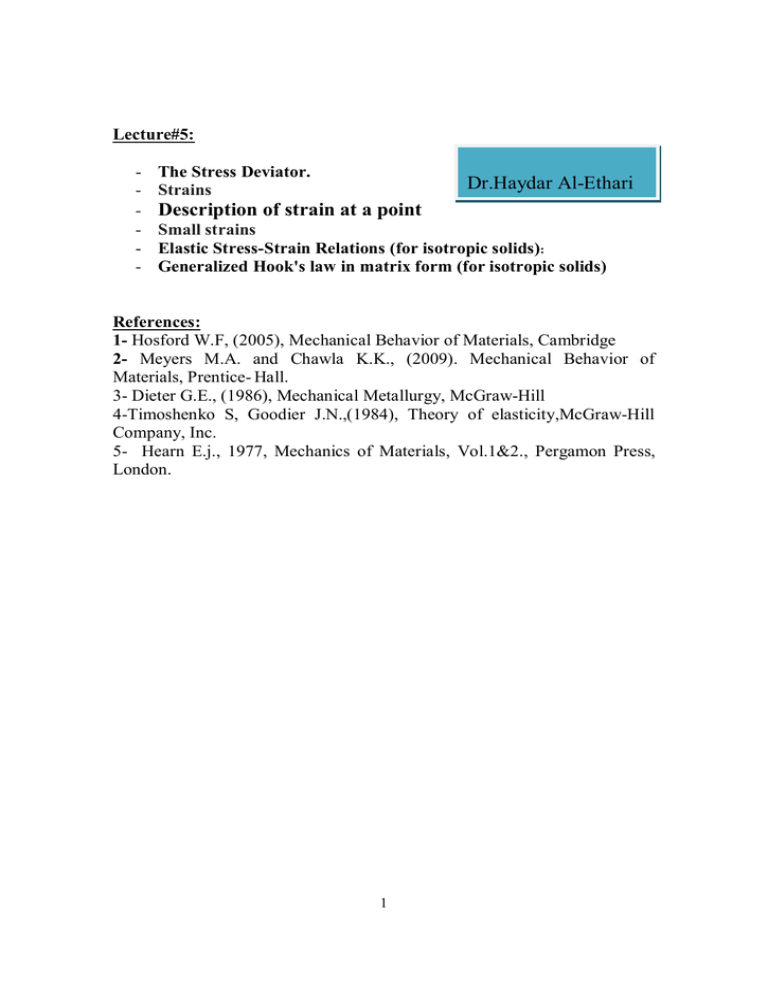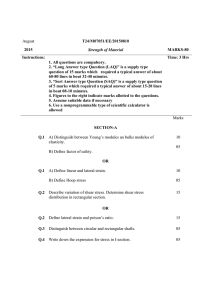Description of strain at a point Dr.Haydar Al-Ethari
advertisement

Lecture#5: - The Stress Deviator. Strains Dr.Haydar Al-Ethari Description of strain at a point Small strains Elastic Stress-Strain Relations (for isotropic solids): Generalized Hook's law in matrix form (for isotropic solids) References: 1- Hosford W.F, (2005), Mechanical Behavior of Materials, Cambridge 2- Meyers M.A. and Chawla K.K., (2009). Mechanical Behavior of Materials, Prentice- Hall. 3- Dieter G.E., (1986), Mechanical Metallurgy, McGraw-Hill 4-Timoshenko S, Goodier J.N.,(1984), Theory of elasticity,McGraw-Hill Company, Inc. 5- Hearn E.j., 1977, Mechanics of Materials, Vol.1&2., Pergamon Press, London. 1 The Stress Deviator Recall: I1 = σ xx + σ yy + σ zz I 2 = σ xxσ yy + σ yyσ zz + σ zzσ xx − σ xy2 − σ yz2 − σ zx2 I 3 = σ xxσ yy σ zz + 2σ xyσ yz σ zx − σ xxσ yz2 − σ yyσ zx2 − σ zz σ xy2 σ 3 − I1σ 2 + I 2σ − I 3 = 0 For a given volume element of a material, we can resolve the stresses acting on the element into a mean (average) stress: 1 1 I σm = (σ1 +σ2 +σ3 ) = (σxx +σ yy +σzz ) = 1 3 3 3 This stress is invariant meaning that its value is independent of the choice of axes. We can consider m to be “hydrostatic”. The average stress represents PART OF the total stress; thus we can define the total stress as follows: σ xx σ xy σ xz σ m 0 0 σ yx σ yy σ yz = 0 σ m 0 + σ 0 σ m zx σ zy σ zz 0 Total stress σ xx − σ m σ xy σ xz Hydrostatic σ yx σ yy − σ m σ yz σ zy σ zz − σ m σ zx Stress Deviator The stress deviator is what causes distortion of the material element. If we take the determinant of the stress deviator in the same way that we took the determinant of the total stress tensor earlier, we generate a new cubic equation that has three new invariants: σ •3 − J1σ •2 + J 2σ • − J 3 = 0 J1 = I1 − σ m = (σ xx − σ m ) + (σ yy − σ m ) + (σ zz − σ m ) J2 = I2 − σ m = = [ 1 ((σ xx − σ yy ) 2 + (σ yy − σ zz ) 2 + (σ zz − σ xx ) 2 + 6(σ xy2 + σ yz2 + σ zx2 )) 6 1 (σ 1 − σ 2 )2 + (σ 2 − σ 3 )2 + (σ 3 − σ1 )2 6 ] We can determine J2 from a simple tensile test. In uniaxial tension, yielding occurs when 1 = yp (yield stress), 2 = 3 =0. Thus J2 becomes: J2 = [ ] [ ] 2 1 (σ 1 − σ 2 )2 + (σ 2 − σ 3 )2 + (σ 3 − σ 1 )2 = = 1 (σ YP )2 + (− σ YP )2 = σ YP 6 6 3 It represents the condition required to cause yielding, and it will be explained later. 2 Description of strain at a point: As bodies deform, they often undergo translation and rotation as well as deformation. Translation and rotation are treated in dynamics Deformation: - Dilatation=change in volume - Distortion=change in shape Small deformations are the province of elasticity theory, while large deformations are treated in plasticity and hydrodynamics. Pure shear without Pure rotation without Simple shear rotation shear Small strains: Strain must be defined in such a way as to exclude ( ) the effects of translation and rotation. Consider the 3-dimensional body shown in the figure below. 3 Shear strains are defined as angles of deformation or changes in angles between two perpendicular segments. Thus is the change in angle between two perpendicular segments in the XY-plane as load is applied: 4 For a 3-dimensional body with displacements w in the z-direction, γ xy = γ yx and γ yz = γ zy Small strains can be treated as tensors, ε xx ε xy ε xz ε ij = ε yx ε yy ε yz ε zx ε zy ε zz where the mathematical shear strains, ε ij , are one-half of the engineering shear strains, γ ij . - The normal strain on an oblique plane: ε = ε xl 2 + ε y m 2 + ε z n 2 + lmγ xy + mnγ yz + γ xz nl - The direction of principal normal strain (no shear strain), for isotropic materials coinside with the principal stress direction and: ε 3 − I1ε 2 + I 2ε − I 3 = 0 I1 = ε XX + ε yy + ε zz ( ) 1 2 γ xy + γ zx2 + γ yz2 4 1 1 I 3 = ε xxε yyε zz + γ yxγ zxγ yz − ε xxγ yz2 + ε yyγ zx2 + ε zzγ xy2 4 4 I 2 = ε xxε yy + ε yy ε zz + ε zzε xx − ( - Maximum shearing strain: γ max . γ 1 = ε 2 − ε 3 ⇒ γ 2 = ε 1 − ε 3 γ = ε − ε 1 2 3 5 ) Contribution ( ), dilatation ( ) Elastic Stress-Strain Relations (for isotropic solids): stress Strain in the x-direction σ XX ε xx = σ yy σ xx E ε xx = − σ ZZ ε xx = − Strain in the y-direction ε yy = − υσ yy E υσ zz E ε YY = υσ xx E ε YY = − ε ZZ = ε YY = τ XZ = Gγ XZ ; G= υσ xx E ε ZZ = − υσ zz E 1 [σ XX − υ (σ YY + σ ZZ )] E 1 = [σ ZZ − υ (σ XX + σ YY )] E τ XY = Gγ XY ; τ YZ = Gγ YZ ; ε zz = − σ YY E ε XX = ε ZZ Strain in the zdirection E ; 2(1 + υ ) υσ YY E σ ZZ E 1 [σ YY − υ (σ XX + σ ZZ )] E K= E 3(1 − 2υ ) K- Bulk modulus, the ratio of stress to strain under uniform pressure conditions = (volumetric stress)/ (volumetric strain) = σ / ε v = (σ xx + σ yy + σ zz )/ (3(ε xx + ε yy + ε zz )) The dilatation is proportional to the mean stress through a constant known as the bulk modulus 6 The constants & µ are known as Lamé’s constants. Young’s modulus and Poisson’s ratio can be written in terms of Lamé’s constants through the equations: Generalized Hook's law in matrix form (for isotropic solids): 1- Stress in terms of strain: σ x σ y σ z σ xy σ xz σ yz (1 − υ )E (1 + υ )(1 − 2υ ) = Symmetric υE (1 + υ )(1 − 2υ ) (1 − υ )E (1 + υ )(1 − 2υ ) υE (1 + υ )(1 − 2υ ) υE (1 + υ )(1 − 2υ ) (1 − υ )E (1 + υ )(1 − 2υ ) 2- Strain in terms of stress: εx ε y εz γ xy γ xz γ yz −υ 1 E E 1 E = Symmetric −υ E −υ E 1 E 0 0 0 0 0 0 1 G 0 1 G 7 0 0 σ x σ y 0 σ z σ 0 xy σ xz 0 σ yz 1 G 0 ε x 0 0 0 ε y ε z 0 0 0 γ xy γ G 0 0 xz G 0 γ yz G 0 0



